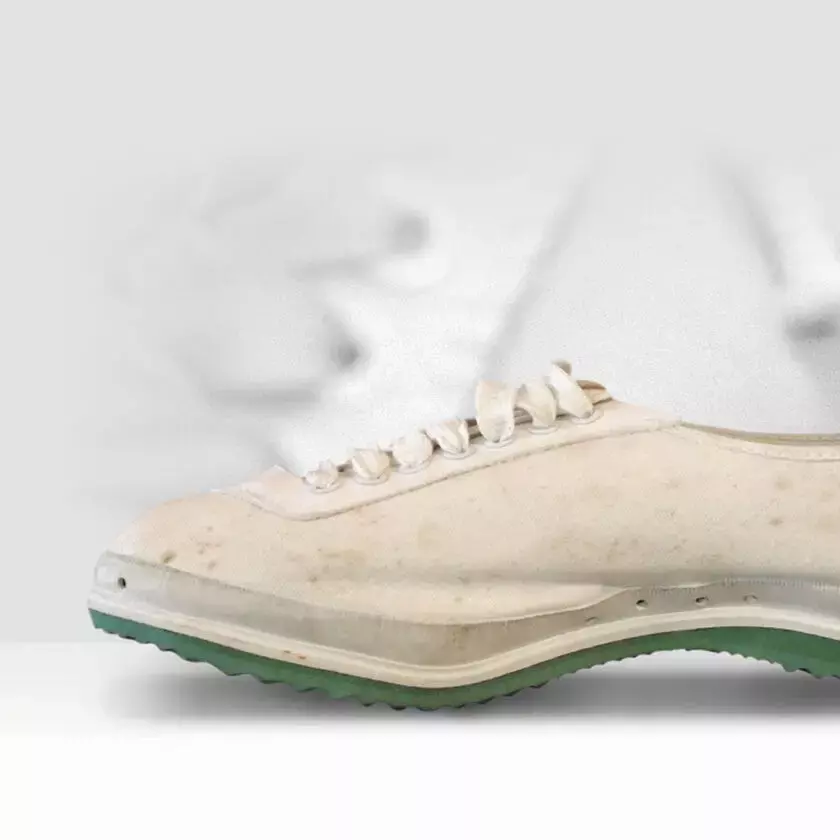In 2024, Onitsuka Tiger marks its 75th anniversary, providing us with an ideal opportunity to delve into the rich history of Onitsuka Tiger. Curious about the journey that transformed this Japanese brand into a global phenomenon, inspiring generations along the way? Keep reading to uncover the fascinating story!
Back to the year 1949
It all began for Onitsuka Tiger in 1949, shortly after the war. Kihachiro Onitsuka believed that “sport has the power to change people's lives.” This was translated into the iconic slogan: “Anima Sana In Corpore Sano,” meaning a healthy mind, in a healthy body.
This philosophy of life was introduced in part with the goal of supporting the youth of Japan and helping them build a better future after the end of the war in 1949. Kihachiro Onitsuka was convinced of the power of sports to unite people and connect communities. In his pursuit of strength and comfort, he brought groundbreaking athletic shoes to the market.
The story of the octopus
Ever thought that an eight-legged delicacy whose tentacles became entangled in a salad bowl could be more than just dinner? Neither did we! Yet this octopus served as the inspiration for Onitsuka Tiger's groundbreaking athletic shoe innovation. Also known as the suction cup sole on the 1951 OK BASKETBALL SHOE.
An innovation that, among others, helped the Japanese high school team win the championship. In fact, the excellent grip allowed basketball players to make fast breakthroughs and sudden stops, which was essential to the game.
Innovations and shoes
In terms of innovations, it's not just the suction cup sole on the BASKETBALL SHOE. As mentioned, the history of Onitsuka Tiger guarantees several groundbreaking shoes.
Onitsuka Tiger MAGIC RUNNER
Kihachiro Onitsuka got a brilliant idea while watching the steam from hot water rippling his toes in the bathtub. After seeing blister-forming patterns from a university medical professor, Onitsuka realized that heat could cause blisters during running. This observation inspired him to focus on improving air circulation in long-distance running shoes.
Drilling holes in the shoes proved to be a revolutionary discovery in 1960. With this, the MAGIC RUNNER was not only lighter but also offered excellent air circulation.
Onitsuka Tiger RUNSPARK
Japanese innovation came to fruition at the 1964 Tokyo Olympics. Here, the iconic RUNSPARK made its debut, featuring Onitsuka Tiger's first fixed track spikes for athletes. Athletes had a choice of four different lengths of spikes, depending on track conditions.
In addition, the shoe line included several structures, including a heel with layers of soft sponges to help absorb shocks upon impact with the ground.
Onitsuka Tiger CALIFORNIA
The CALIFORNIA was designed with jogging in mind. It supported the arch of the foot and offered firm support to the toes. In addition, the form-fitting insole allowed plenty of room for natural movement of the toes. The wide, rounded heel promoted balance when landing, while the wide, upward-curving toe provided good forward movement.
In addition, reflective patches were stitched onto the back of the shoes. With these safety measures, runners were visible to automobiles up to 300 meters away at night or on rainy days.
The iconic Tiger stripes
In 1966, Onitsuka Tiger stripes made their debut, first seen on the LIMBER UP Leather BK introduced for the 1968 Mexico Olympics.
And speaking of stripes, Onitsuka Tiger earned its stripes as one of the top athletic shoe manufacturers in Japan in history, by delivering outstanding performances at major international events, attracting the attention of the rest of the world.
Onitsuka Tiger and Nike
One of those who developed an interest was Phil Knight. While studying business administration in athletic shoe marketing, he met Kihachiro Onitsuka. This encounter inspired Knight to start Blue Ribbon Sports, with the goal of bringing Onitsuka Tiger shoes to the United States.
At the request of Blue Ribbon Sports, Onitsuka Tiger created the Tiger Cortez. This shoe was designed specifically for the American market, where there was a demand for a shoe with improved cushioning. It proved to be a huge success, and in the meantime, Blue Ribbon Sports transformed into Nike.
Not long after, Nike launched its own version of the Cortez, this time with the iconic Swoosh logo. This even resulted in a lawsuit over who would have the rights over the name. The final decision fell in Nike's favor, forcing Onitsuka to reintroduce their shoe under the name Tiger Corsair.
From Onitsuka Tiger to ASICS
Fast-forward to 1977, the Japanese brand merged with GTO Co. and JELENK Co. After this merger, the company was officially renamed “ASICS”, an abbreviation of the Latin saying Anima Sana In Corpore Sano.
This acquisition also meant that the Onitsuka Tiger brand temporarily disappeared from the public eye. Nevertheless, many years later, Onitsuka Tiger was given a fresh start as a fashion brand in Europe in 2002, driven by the retro trend.
Onitsuka Tiger today
Still, the brand remains progressive with fashionable items, both inspired by heritage styles from the archive and high-end fashion trends. Also, the iconic stripes still adorn the sides of Onitsuka Tiger and ASICS shoes!
Classics have been renewed, reinterpreted, and reinvented. Using the original Onitsuka Tiger athletic shoes as a base, modifications were made in the fits, colors, and construction to reshape the MEXICO 66, CALIFORNIA 78, and NIPPON MADE.
In November 2023, it was announced that Onitsuka Tiger was discontinuing sales on its U.S. website. Lucky for us sales still continue on other global Onitsuka Tiger sites, including those for the EU, Japan, and Great Britain.
So would you like to experience the wonders of Japanese craftsmanship yourself? Then take a look at Onitsuka Tiger's shoe collection with the Sneakerjagers search engine!














